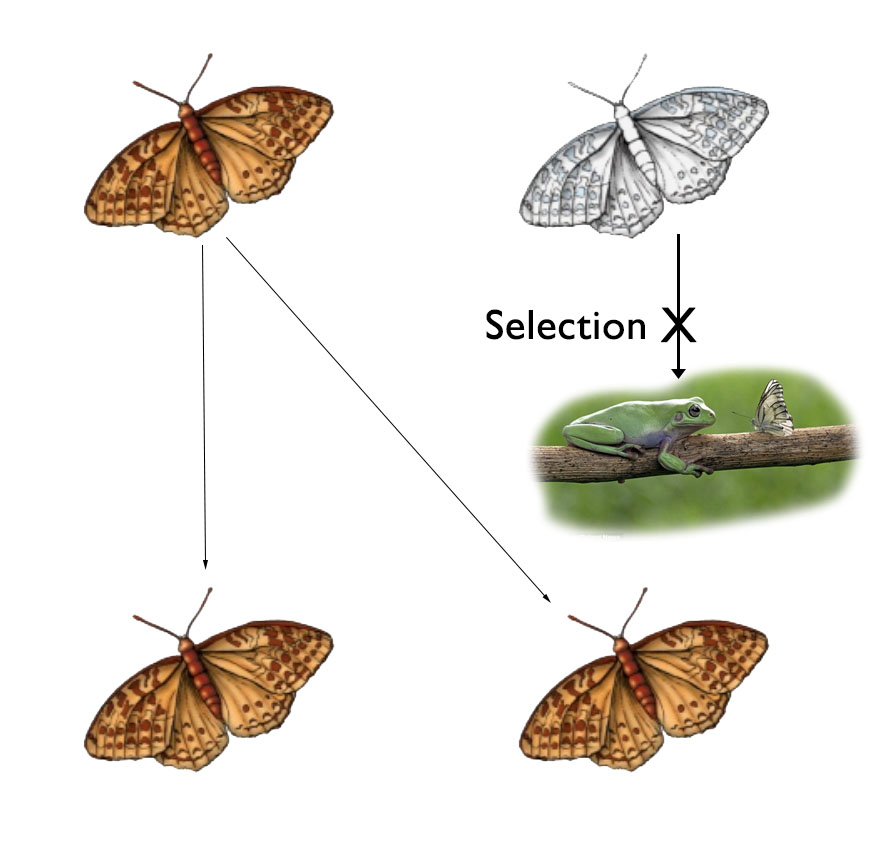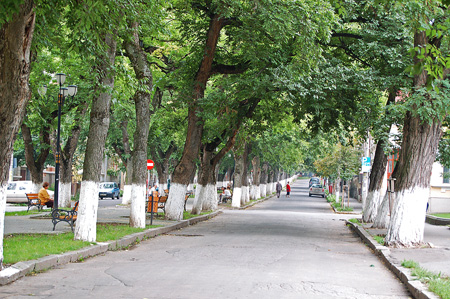A simple model of butterfly gene selection

We have conclude that the diversity is fatal to the survive of one species. However we have not shown how evironment can affect gene distribution, which is called selection. Suppose that there is a sudden invasion of new pradators, for example frog, which can only recognize white butterflies since they cannot distinguish gray butterflies with trunk of trees. Therefore, white butterflies face higher level of danger of being caught. The ability to adapt a certain environment is called fitness.
Simulation
Similar to previous simulation, we define \( x_{11} \) as the number of butterflies that have \(AA \) genotype, \(x_{12}\) as the number of those have \(Aa\) and \(x_{22}\) as for \(aa\). Suppose there are \(N=x_{11}+x_{12}+x_{22}\) butterflies and we want to reproduce the next generation of \(N\) butterflies. Their parents are chosen randomly from the previous generation and randomly inherit one allel from each parent. Let \(A\) has probability \(\mu_1\) to become \(a\) and \(a\) has probability \(\mu_2\) to become \(A\) during each mating. Furthermore, we define the fitness of three genotypes as \(1,1-hs\) and \(1-s\), where \(h\) is 0 by default by our assumption since there is no distinguishable difference for \(AA\) and \(Aa\), but you are free to adjust these parameters (even try negative values but ensure that their absolute value does not exceed 1 and think what it means). The survive probability of each individual before they reproduce their offsprings will be proportional to their fitnesses. We run this recursively to see how the ratio of each genotype evolves through \(T\) generations. Try different parameters below to see how 2 phenotypes and 3 genotypes vary.
- \(x_{11}\)=
- \(x_{12}\)=
- \(x_{22}\)=
- \(\mu_{1}\)=
- \(\mu_{2}\)=
- \(T\)=
- \(h\)=
- \(s\)=
Fixation and loss

The fixation process with selection is immediate and reshapes the steady state by a shift to more favorable genotype, however it cannot eliminate unfavorable genotype since the mutaion and shift process does not allow that. Therefore if somehow the tree trunk becomes white, e.g. by white painting to avoid borers, the butterflies are still able to survive by rapid change from gray to white. Diversity roots in the nature!
Math desciption of fitness
We are still using allel frequency \(0\leq x=x_{A}/{2N} \leq 1 \) to simplify the calculation for fitness evolution. If parents are chosen randomly, the offsprings will have expected population of \(x_{11}=x^2*N,x_{12}=2x(1-x)N\) and \(x_{22}=(1-x)^2 N\). We define average fitness of this generation by normalization of the fitnesses:
$$\overline{f}(x)=x^2f_{11}+2x(1-x)f_{12}+(1-x)^2f_{22}.$$
Take our assumption for three different fitnesses into the above equation and we can easily write
$$\overline{f}=x^2+2x(1-x)(1-hs)+(1-x)^2(1-s)=(1-s)+2s(1-h)x+s(2h-1)x^2.$$
Try play with different parameters below and see how the average fitness changes, remember that average fitness means the ability to adapt to a certain environment and the maximum value is always the most favorable for survive.
- \(h\)=
- \(s\)=
Steady probability distribution
In previous sections withour selection we conclude that steady allel frequency distribution is approximately
$$p^*(x)\propto \frac{1}{x(1-x)}\times x^{4N\mu_2}\times (1-x)^{4N\mu_1}.$$
The behavior is quite similar with selection, and it can be proved that:
$$p^*(x)\propto \frac{1}{x(1-x)}\times x^{4N\mu_2}\times (1-x)^{4N\mu_1}\overline{f}(x)^{2N}.$$
Actually it means that there is a mutation selection balance, and you can see how things change compare to no selection case below:
- \(\mu_1\)=
- \(\mu_2\)=
- \(N\)=
- \(h\)=
- \(s\)=
You might find that the shape of \(p(x)\) is close to normal distribution when \(N\) is large. This is a statistical behavior called central limit theorem. It also says that the variance of the distribution will decrease when \(N\) is large. That means for a large population the distribution of the gene pool is almost independent of time.
More about evolution
Since there are 37.2 trillion cells in every human body, the mutation happens every seconds. A lot of disease such as cancer are results of those "bad" mutations. We have observed that if one mutate gene starts with small population but higher fitness, it will soo occupy most of the population. There are also sometimes deleterious mutations cannot be selected out in time. The accumulation of harmful gene is call population meltdown. Human have developed other self defense mechanism to decrease the harm of this process. The nature cooperates in every level to form a harmonic and developing world. There are still more unknown processes that are waiting for you to discover in the furture.
